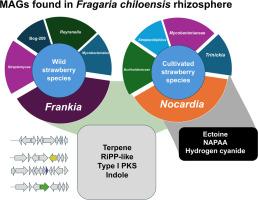Comparative metagenomics of wild and cultivated Fragaria chiloensis reveals major rhizosphere microbiome shifts linked to stress adaptation
IF 5.8
Q1 MICROBIOLOGY
引用次数: 0
Abstract
Fragaria chiloensis ssp. chiloensis, endemic to Chile, includes a wild form (f. patagonica) and a cultivated “white strawberry” (f. chiloensis) historically grown in central-south Chile. In this study high throughput metagenomic sequencing was employed to examine the rhizosphere microbial communities of wild and cultivated plants were examined to explore how domestication has shaped microbial structure and function. This enabled binning and functional annotations indicating that wild rhizospheres were dominated by Frankia and Bradyrhizobium, whereas cultivated samples exhibited broader genus‐level diversity yet preserving a core ecological function through functional redundancy. Metabolic reconstructions further spotlight high‐biomass taxa, with Frankia in wild plants and Nocardia in cultivated plants, that harbored extensive biosynthetic gene clusters, linking robust growth to specialized metabolite production and putative osmoprotection. Collectively, these findings illustrated how domestication reshapes the rhizosphere microbiome and contributes to One Health-aligned strategies for sustainable agriculture.

野生和栽培辣椒的比较宏基因组学揭示了与胁迫适应相关的主要根际微生物组变化
紫枝花chiloensis,智利特有,包括野生品种(f. patagonica)和栽培的“白草莓”(f. chiloensis),历史上生长在智利中南部。本研究采用高通量宏基因组测序技术对野生和栽培植物的根际微生物群落进行了分析,探讨了驯化对植物根际微生物结构和功能的影响。这使得分类和功能注释表明野生根际以法兰克根瘤菌和缓生根瘤菌为主,而栽培样品则表现出更广泛的属级多样性,但通过功能冗余保留了核心生态功能。代谢重建进一步聚焦高生物量分类群,如野生植物中的Frankia和栽培植物中的Nocardia,它们拥有广泛的生物合成基因簇,将强劲的生长与专门的代谢物生产和假定的渗透保护联系起来。总的来说,这些发现说明了驯化如何重塑根际微生物群,并有助于可持续农业的“一个健康”战略。
本文章由计算机程序翻译,如有差异,请以英文原文为准。
求助全文
约1分钟内获得全文
求助全文
来源期刊

Current Research in Microbial Sciences
Immunology and Microbiology-Immunology and Microbiology (miscellaneous)
CiteScore
7.90
自引率
0.00%
发文量
81
审稿时长
66 days
 求助内容:
求助内容: 应助结果提醒方式:
应助结果提醒方式:


